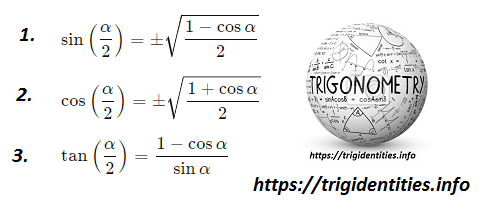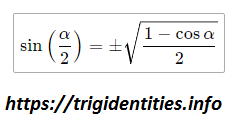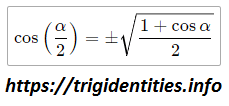Trig half angle identities or functions actually involved in those trigonometric functions which have half angles in them. The square root of the first 2 functions sine & cosine either negative or positive totally depends upon the existence of angle in a quadrant. Learn more about Trig Identities at trigidentities.info.
Here comes the comprehensive table which depicts clearly the half-angle identities of all the basic trigonometric identities. Explore more about Inverse trig identities.
Derivation of Trig Half-Angle Identities
Today we are going to derive following trig half-angle formulas.
Half Angle Formula – Sine
- cos 2θ = 1− 2sin2 θ
Now, if we let
- θ = α/2
then 2θ = α and our formula becomes:
- cosα=1−2 sin2(2α )
We now solve for
- Sin (α/2)
- 2 sin2(2α )=1−cosα
- sinˆ2 (2α) = 1 – cosα
Solving gives us the following sine of a half-angle identity:
Now let talk about the positive or negative sign of Sin (α/2).
- If the angle lies in the first quadrant then all positive means sine half angle identity will be positive.
- And if it is in 3rd or 4th quadrant we will introduce a negative sign with the sine half angle identity.
Half Angle Formula – Cosine
Simply by using a similar process, With the same substitutions, we did above. Now we have to substitute these values into the following Trig identity.
- cos 2θ = 2cos2 θ – 1
After substituting the values We
- Cosα = 2 cosˆ2(α/2)-1 —–(1)
Now you need to reverse the equation.
Reverse the equation:
- 2 cosˆ2(α/2)-1 = Cosα —–(2)
Add both eq (1) & (2)
- 2 cosˆ2(α/2) = 1+cosα
Divide by 2 on both sides
- cosˆ2(α/2) = 1+cosα/2
Taking square root on both sides we got cosine half angle formula now
let’s talk about the positive or negative sign of Cosine (α/2).
- If the angle lies in first or 4th quadrant then Cosine(α/2) will be positive
- And if it is in 2nd or 3rd quadrant we will introduce a negative sign with the cosine half angle identity.



